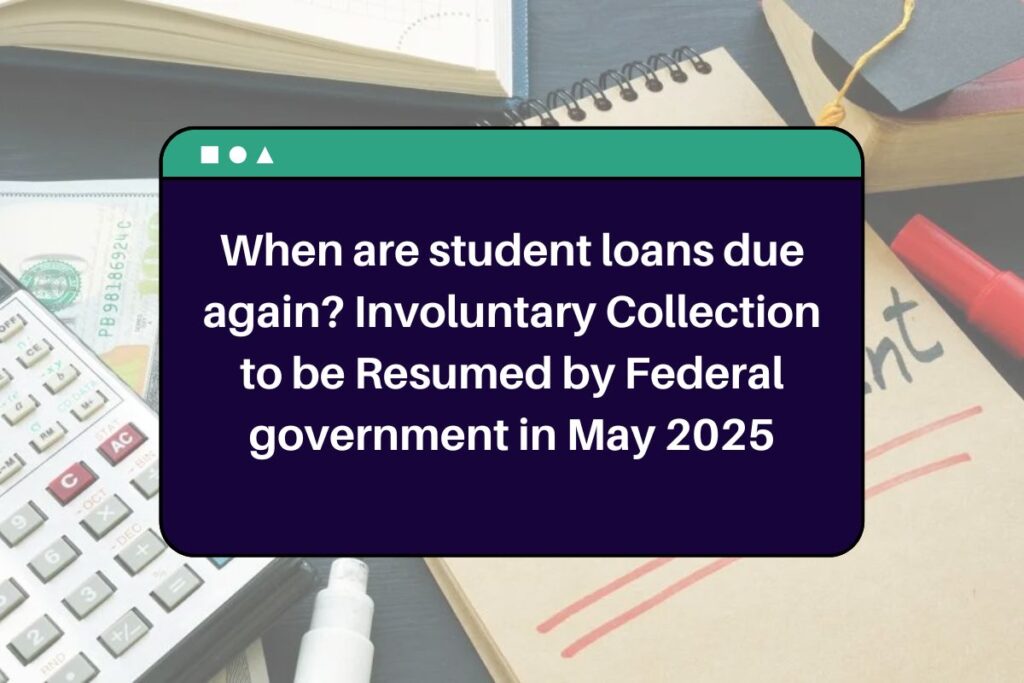On 21 April 2025, the Department of Education of the U.S. stated that its Office of Federal Student Aid (FSA) will start collecting federal student loans of the defaulted students from 5 May 2025. In March 2020, the Education Department of the U.S. paused the collection of federal student loans under the CARES Act. The main aim behind freezing the collection of federal student loans was to alleviate financial pressure of the borrowers at the time of Covid-19 pandemic.
When are student loans due again?
This announcement has troubled a number of Americans who have failed to pay their federal loan amount on time. The amount of loans which will be collected from May 2025 are Pell Grants, Perkins Loans, Direct Loans, Federal Family Education Loans and many more. Hence, if you are an individual who has taken one of these loans and want to get the latest update about the involuntary collections of loans then you can read the present article.
Key updates regarding the federal student loan collections
The government of the U.S. will begin to collect loan amounts from the defaulted students with the help of the Treasury Offset Program. It is the key instrument which U.S officials use for seizing federal benefits and tax refunds. So, under this program, emails will be sent to the defaulted students in which the Department of Education urges borrowers to begin the loan recovery proceeding or enroll into a Income-driven repayment plan. The involuntary collection of student loans will begin from 5 May 2025 by the Office of Federal Student Aid (FSA).
Linda McMahon, who is secretary of the Education Department said that the involuntary collection of the federal student loans amount is an act of restoring accountability. Furthermore, according to Linda McMahon, the defaulted borrowers are in huge numbers thus it is essential to collect the debt amount so that the system can be brought back into balance for both the taxpayers and borrowers.
As per the report of Federal Student Aid (FSA), from the past year, over five million borrowers have not paid installments of their federal student loan. Many defaulters of student loans did not pay any amount from the past 7 years. The officials have also stated that a total of $1.6 trillion is due in the federal student loans by 42.7 million borrowers. Furthermore, the number shows that only 38% of student loan borrowers are paying their debt amount timely and enrolled in repayment programs.
Thus, it has made it essential for the Department of Education of the U.S. to begin involuntary collection of student loans for keeping system balance on the right track.

Trump administration statements regarding the involuntary collections
The secretary of the Education Department Linda McMahon criticised the Biden administration for misleading borrowers of federal student loans and stopping the process of debt repayment. She also stated that it is not the responsibility of taxpayers to pay the student debt of defaulted students as it will be an extra burden on them.
The Education Department along with the Treasury Department will start the Treasury Offset Program on May 5th 2025 for involuntarily collecting the delinquent debts from the borrowers of federal student loans. Under this program, the FSA will reach out to the defaulted students through emails, social media and other communication mediums. The official stated that they will encourage borrowers to apply for loan rehabilitation or enroll in an income-driven repayment plan.
The payments and benefits which will be deducted under involuntary collections
Under the Treasury Offset program, the social security benefits, tax refunds and a portion of income can be withheld by the U.S. government. The Department of Treasury announced that it can deduct 100 percent travel payments, over 25% federal retirement payments, 15% of Railroad Retirement and Social Security benefits, over 15% of federal wages, and 100% of federal tax refunds of the defaulted borrowers of the federal student loans.
The education department also announced that they will garnish the income of defaulted borrowers under the Treasury Offset Program. The Garnishment of income will start in the late of June 2025, in which, over 15 percent of the salary of the defaulted borrowers will be deducted by their employer on the orders of the loan holders. It will allow the Department of Education clear the student debt in a legal manner.
Although, according to the Federal Student Aid, the U.S. government has registered few loans in deferment that means in certain cases debtors do not have to pay their federal student loan debt amount. The government will postpone the loan forgiveness of those borrowers who have disability, are working military services, undergoing graduate fellowship, economic hardships, cancer treatment, and studying currently. But, the loan payment or forgiveness of those borrowers will be paused in the deferment case.
Effective ways through which borrowers can stop involuntary collections?
Government officials of the Education Department advised some effective ways to the defaulted students for avoiding the involuntary collections. One of the best ways is rehabilitation of loans in which defaulters can pay 9 consecutive installments of their loans to their loan holders. Furthermore, officials also advised to transfer the loan amount into a new Direct Consolidated Loan or borrowers can also clear their debt by paying the lump sum.
The other way through which borrowers can pay their debt without involuntary collection is by enrolling into an Income-driven repayment (IDR) plan. It will allow defaulters to set the monthly payment amount for debt clearance according to their family size and income.
Bottom Line
The Trump administration has begun collecting federal student loans of defaulted students from 5 May 2025. As a result, it creates several challengers for defaulted borrowers who thought their student loans have been forgiven by the Biden government. The key justification given by the Secretary of Education Department regarding the involuntary collection of loans is to bring the system back into balance for both the taxpayers and borrowers.
| Official Website | Click Here |
| Homepage | UniversityPressClub.Com |

